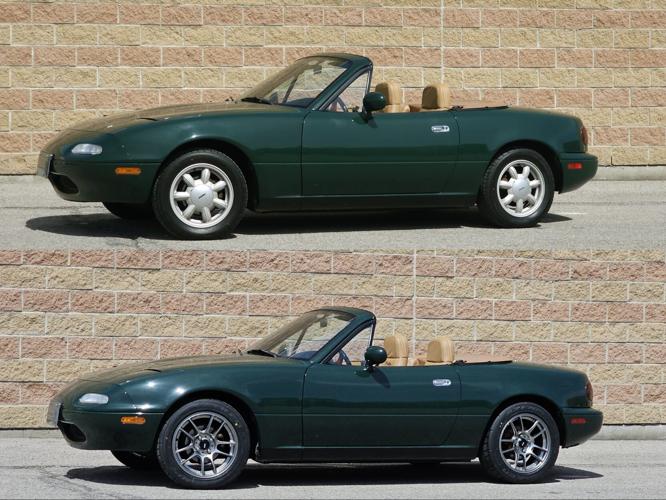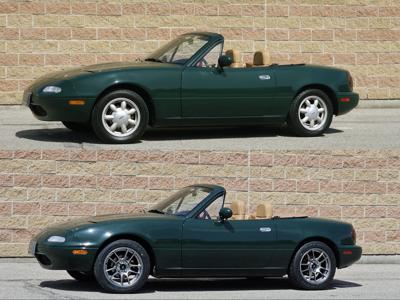My wife, Barb, has just become the owner of a lovely British Racing Green 1991 Mazda (MX-5) Miata. The Japanese automakerŌĆÖs tiny droptop roadster has long been a favourite of ours, a fondness created by the test vehicles back I drove back when I did car reviews for the Star. Our enthusiasm for the Miata was confirmed by renting a current model through Turo during a Hawaiian vacation a few years ago.
Apart from tackling some maintenance items and having the age-worn seat covers and fabric roof replaced, there was one specific change Barb asked me to make to her new-to-her car: wheels and tires.
Thirty-four years ago, 14-inch wheels and tires were common on sporty cars, such as the Miata; AcuraŌĆÖs Integra, NissanŌĆÖs Sentra SE-R, even the Volkswagen GTI, wore that size. Today, youŌĆÖd be hard-pressed to find a 14-inch tire on a new vehicle ŌĆö the diminutive Mitsubishi Mirage is the last one I can think of. As theyŌĆÖve been primarily an economy-car fitment for decades, enthusiast-oriented choices in the MiataŌĆÖs original size are effectively zero.
Telling you that tire selection was the major factor for her would be lying; itŌĆÖs mostly about the looks.
Put simply, sheŌĆÖs underwhelmed by the carŌĆÖs original alloy wheels and tall sidewall tires. Having ŌĆ£plus-sizedŌĆØ the wheels and tires on one of her prior vehicles, she knows that nothing changes the overall appearance of a vehicle as much and as easily as different wheels.
If you doubt that to be true, consider what a lightly corroded set of black steel wheels and winter tires do to the looks of even a really nice car ŌĆ” which is why especially at this time of year, a lot of people put better-looking wheels and tires on their cars and trucks.
Provided you keep the original wheels and tires, itŌĆÖs simple to return the car back to them, if you want to sell or trade it in. This is a lease and resale friendly customizing option.
Changing the wheel and tire sizes from those the vehicle originally came with can alter how it rides and handles noticeably ŌĆö for good or bad ŌĆö so itŌĆÖs best to understand that relationship.
And there are a surprising number of variables involved in just picking a wheel that can be installed on your vehicle.
Take Barb’s Miata, for example. Let’s start with the number of nuts (or bolts) that hold the wheel on: four.
Easy, right?
Not so fast! ItŌĆÖs not just the number; the spacing of the fasteners can differ, too. Called ŌĆ£bolt circle,ŌĆØ ŌĆ£bolt pattern,ŌĆØ or ŌĆ£PCDŌĆØ (pitch circle diameter), itŌĆÖs the diameter of a circle passing through the centre of the fasteners or the holes in the wheels. In BarbŌĆÖs Mazda, itŌĆÖs 100 millimetres, so ŌĆ£4x100.ŌĆØ If it had five fasteners in the same diameter, itŌĆÖd be 5x100. (My Subaru uses that one.) Engineering needs and appearance probably both influence the pattern chosen by the automaker.
In the centre of the vehicleŌĆÖs wheel hub is a raised area sometimes called the ŌĆ£pilot,ŌĆØ used to locate and support the wheel. Virtually any original-equipment wheel will have a matching-sized centre hole, the ŌĆ£bore”; this provides whatŌĆÖs known as a ŌĆ£hub-centricŌĆØ fit.
Pilot/bore sizes also vary. Bore and bolt patterns alone will dramatically narrow your potential wheel choices.
Aftermarket wheels often have large bores to allow them to fit as many applications as possible; too small and the wheel canŌĆÖt be installed.
The MiataŌĆÖs pilot is just 54.1 mm, and the Konig wheels Barb chose have a sizable 73.1-mm bore, so they definitely clear. Although that mismatch precludes the pilotŌĆÖs locating and supporting role, ŌĆ£hub-centering rings,ŌĆØ or ŌĆ£centric-ringsŌĆØ are available that act as an adapter to fill that gap. This prevents the wheel fasteners from having to locate and support the wheel as well as keep it attached ŌĆö a less ideal ŌĆ£lug-centricŌĆØ fit.
Just when you think it couldnŌĆÖt get any more complicated, there are two other important considerations: offset and wheel width.
Offset is the distance, in millimetres, from the centre-line of the wheel to the wheelŌĆÖs mounting surface.
All else being equal, a more positive offset positions the wheel (and tire) further inwards relative to the body, while less positive locates it outwards.
Most modern vehicles use a positive offset ŌĆö that is, the mounting surface is further towards the outside of the wheel. This provides space in behind the wheelŌĆÖs face for the brakes, among other things.
Changing the offset can alter the steering effort, stability, and, if the change is drastic enough, potentially shorten the life of the suspension and wheel bearings. Probably a half-dozen or more times a year, I encounter customer vehicles where theyŌĆÖve installed wheels with too little offset and now have body and suspension rubbing issues when turning.
This is why I suggest either going with a factory-approved wheel set, or talking to a professional before buying. Particularly if you’re changing tire-sizing, I recommend staying within five to 15 millimetres less than your original wheelsŌĆÖ offset.
First-generation Miatas, such as the one Barb has, had a 45-mm or 40-mm offset. To prevent changing the carŌĆÖs driving character appreciably and avoid rubbing, we picked wheels with a 35-mm offset, about as close to original as was readily available.
To get the look she wanted, to avoid completely ruining the carŌĆÖs ride by having too thin of a tire sidewall, which is, in effect, the first part of a carŌĆÖs suspension, and to provide some varied tire choices, we decided on wheels of a 15-inch diameter.
At seven inches, we kept the wheel-width as close as possible to the original wheelŌĆÖs narrow, 5.5-inch dimension, because we didnŌĆÖt plan to fit tires that were substantially wider.
The choices of tire size and wheel width are directly related, and thereŌĆÖs a whole rationale behind that decision-making ŌĆ”.
Ask a Mechanic is written by Brian Early, a Red Seal-certified Automotive Service Technician. You can send your questions to wheels@thestar.ca. These answers are for informational purposes only. Please consult a certified mechanic before having any work done to your vehicle.






























To join the conversation set a first and last name in your user profile.
Sign in or register for free to join the Conversation